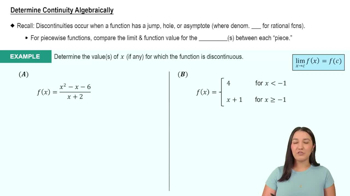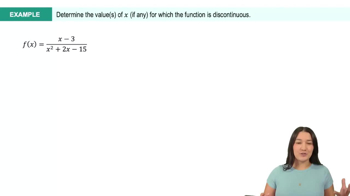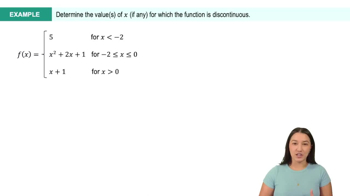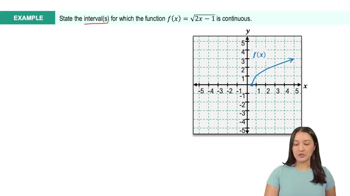Table of contents
- 0. Functions7h 52m
- Introduction to Functions16m
- Piecewise Functions10m
- Properties of Functions9m
- Common Functions1h 8m
- Transformations5m
- Combining Functions27m
- Exponent rules32m
- Exponential Functions28m
- Logarithmic Functions24m
- Properties of Logarithms34m
- Exponential & Logarithmic Equations35m
- Introduction to Trigonometric Functions38m
- Graphs of Trigonometric Functions44m
- Trigonometric Identities47m
- Inverse Trigonometric Functions48m
- 1. Limits and Continuity2h 2m
- 2. Intro to Derivatives1h 33m
- 3. Techniques of Differentiation3h 18m
- 4. Applications of Derivatives2h 38m
- 5. Graphical Applications of Derivatives6h 2m
- 6. Derivatives of Inverse, Exponential, & Logarithmic Functions2h 37m
- 7. Antiderivatives & Indefinite Integrals1h 26m
- 8. Definite Integrals4h 44m
- 9. Graphical Applications of Integrals2h 27m
- 10. Physics Applications of Integrals 2h 22m
1. Limits and Continuity
Continuity
Problem 2.8c
Textbook Question
Limits and Continuity
On what intervals are the following functions continuous?
c. h(x) = cos x / x―π
 Verified step by step guidance
Verified step by step guidance1
Identify the type of function: The function h(x) = cos(x) / (x - π) is a rational function, which is generally continuous everywhere except where the denominator is zero.
Determine where the denominator is zero: Set the denominator equal to zero to find the points of discontinuity. Solve the equation x - π = 0, which gives x = π.
Analyze the continuity: Since the function is a rational function, it is continuous on its domain, which is all real numbers except where the denominator is zero.
Express the intervals of continuity: The function is continuous on the intervals (-∞, π) and (π, ∞), as these intervals do not include the point where the denominator is zero.
Conclude the analysis: Therefore, the function h(x) = cos(x) / (x - π) is continuous on the intervals (-∞, π) and (π, ∞).
 Verified video answer for a similar problem:
Verified video answer for a similar problem:This video solution was recommended by our tutors as helpful for the problem above
Video duration:
1mPlay a video:
Was this helpful?
Key Concepts
Here are the essential concepts you must grasp in order to answer the question correctly.
Continuity of Functions
A function is continuous at a point if the limit of the function as it approaches that point equals the function's value at that point. For a function to be continuous over an interval, it must be continuous at every point within that interval. This concept is crucial for determining where a function does not have breaks, jumps, or asymptotes.
Recommended video:

Intro to Continuity
Limits
Limits describe the behavior of a function as it approaches a specific point from either side. Understanding limits is essential for analyzing continuity, especially at points where the function may not be explicitly defined, such as points of division by zero. Evaluating limits helps identify potential discontinuities in the function.
Recommended video:

One-Sided Limits
Piecewise Functions
Piecewise functions are defined by different expressions over different intervals. When analyzing continuity for such functions, it is important to check the limits and values at the boundaries of these intervals. This concept is relevant for determining the overall continuity of functions that may behave differently in separate segments.
Recommended video:
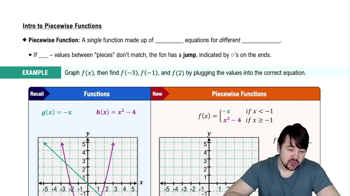
Piecewise Functions
Related Videos
Related Practice




